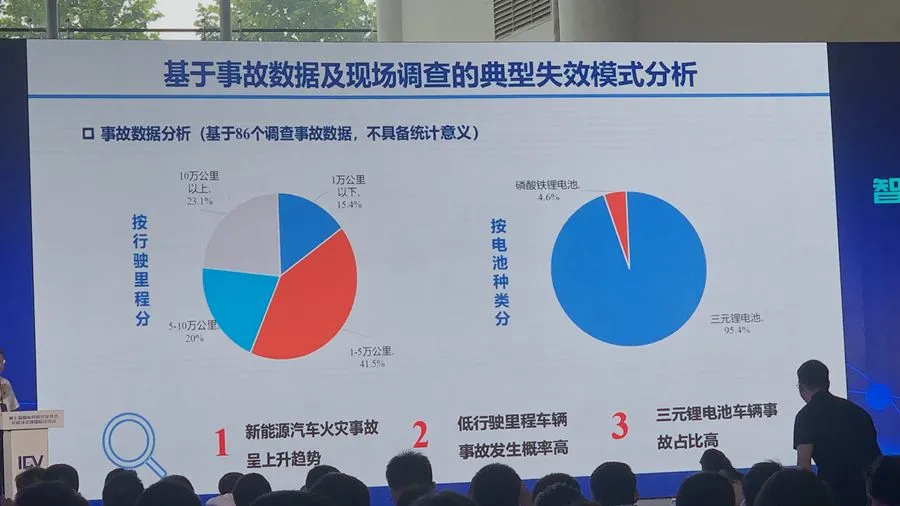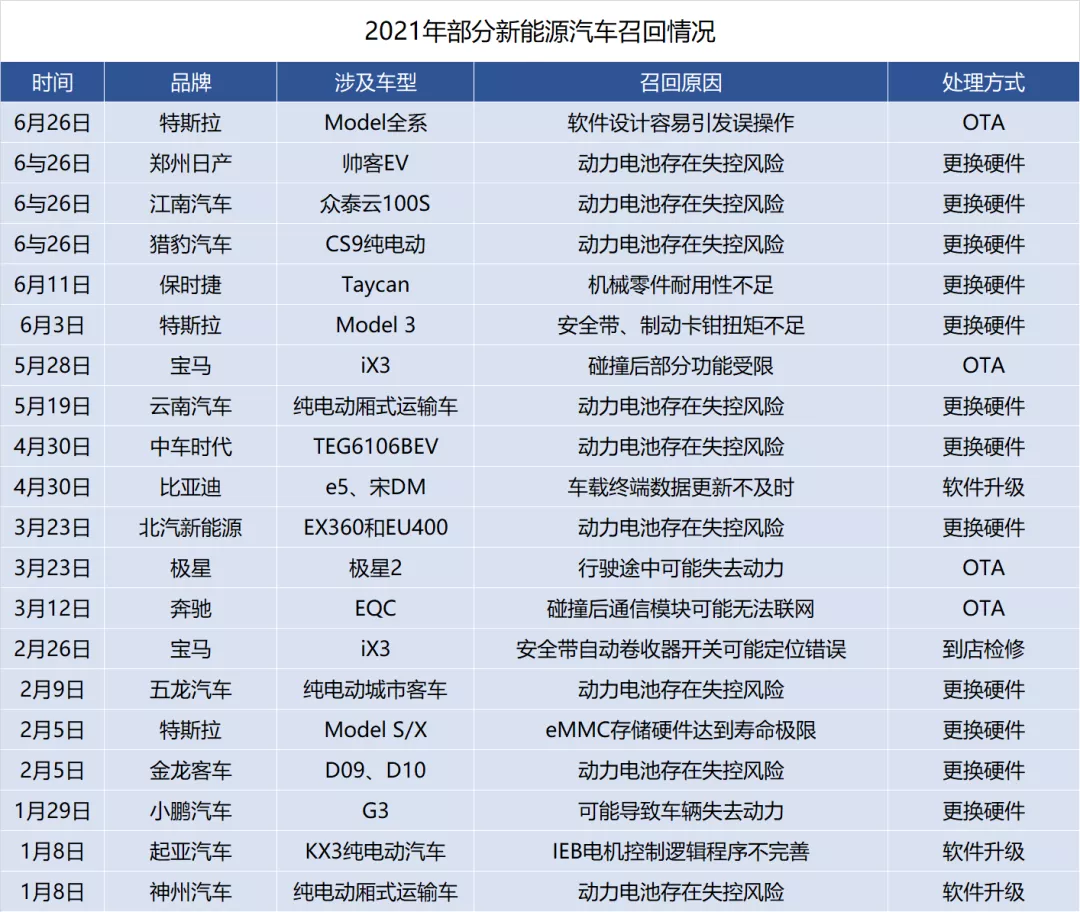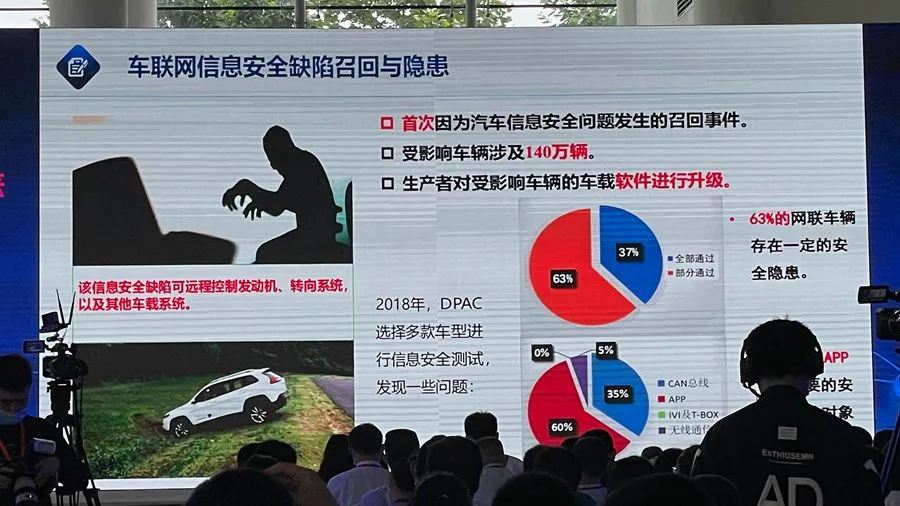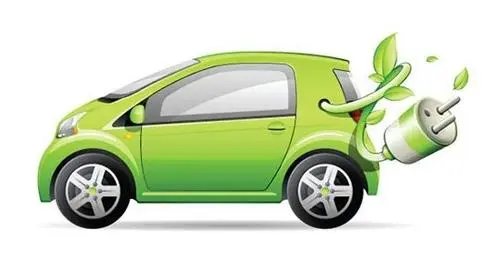Author: Tian Hui
In recent years, the focus in the field of new energy vehicles has shifted from “range anxiety” to “safety anxiety”.
According to Xiao Lingyun, Director of the Car Department of the Defective Product Management Center of the State Administration for Market Regulation, speaking at the International Exchange Conference on Intelligent Connected Vehicle Technology and Standards and Regulations held on July 7th, this year alone, there were 33 recalls related to new energy vehicles.
He believes that safety concerns for new energy vehicles pose new challenges for standards, safety regulation, and innovation in corporate quality improvement.
In addition, since the first vehicle recall in China in 2004, China’s automotive industry has experienced 2191 recalls over 15 years, involving a total of 82.56 million vehicles or 30% of the car ownership.
In the era of intelligent electric vehicles, software defects in intelligent vehicles and electrical system defects in new energy vehicles have become new challenges for the vehicle recall system.
As the regulatory authority for vehicle recalls, the supervision of the State Administration for Market Regulation is undoubtedly very important, and as the person directly responsible for vehicle recalls, Xiao Lingyun’s views on recalls for intelligent electric vehicles are of particular concern.
Power batteries are the main cause of fires
The safety risks of new energy vehicle fires are an issue that cannot be avoided by the entire automotive industry.
In the spring of 2019, the State Administration for Market Regulation issued the “Notice on Further Strengthening the Recall Management of New Energy Vehicle Products,” followed by the establishment of the New Energy Vehicle Fire Accident Collaboration Network and the improvement of the new energy vehicle fire reporting system, which requires all new energy vehicle fires in the Chinese market to be reported to the State Administration for Market Regulation.
As a result, in 2019, the State Administration for Market Regulation had detailed data on new energy vehicle fires.
There is a view in public opinion that the rate of new energy vehicle fires is lower than that of traditional vehicle fires. However, Xiao Lingyun believes that from the perspective of a single component causing a fire, new energy vehicles are more vulnerable than traditional vehicles. Although not explicitly stated, the single component Xiao Lingyun refers to is likely the power battery.
Based on the new energy vehicle fire reporting system of the State Administration for Market Regulation, Xiao Lingyun conducted a failure mode analysis after on-site investigation of 86 new energy vehicle fire accidents.According to statistics from 86 data samples, most fires in new energy vehicles are caused by faults in the power battery, with secondary reasons being electronic and electrical failures and water ingress into the power battery pack. In power battery failures, thermal runaway of the battery cells is the most common cause, followed by low-voltage circuit faults inside the battery pack caused by various temperature and voltage sensor circuits and high-voltage circuit faults inside the battery pack being the least common.
Therefore, from the perspective of data and failure mode analysis, thermal runaway of battery cells is the main cause of fires in new energy vehicles, and incidents of new energy vehicle fires are currently on the rise.

Statistics by Xiao Lingyun on 86 data samples indicate that the mileage of new energy vehicles that catch fire is generally not long, whereas incidents of fires in traditional fuel vehicles mainly occur during long-distance travel. In addition, the proportion of accidents involving ternary lithium battery vehicles is relatively high.
It should be noted that due to the small sample size, Xiao Lingyun emphasizes that this analysis is based solely on 86 samples and does not have statistical significance.
OTA upgrades must be filed
In the first half of 2021, 33 new energy vehicles have been recalled, compared to only 45 for the entire year of 2020.
Clearly, the frequency of recalls for new energy vehicles is increasing.

From publicly available recall information, the number of OTA recalls has surpassed the number of recalls requiring software upgrades at dealerships. OTA recalls have the advantage of not requiring consumers to drive to 4S stores for software upgrades, making the process more convenient.
However, some public opinion contends that OTA upgrades are a cover-up for software defects in car companies.
Xiao Lingyun believes that OTA is a very good implementation solution in the automotive after-sales maintenance field. OTA is not a new model, but a new technology. There are clear regulations for recall and implementation methods that state that any automotive enterprise conducting technical service activities in the market must file for registration. OTA, as a technical service activity, also requires registration.
In 2020, the State Administration for Market Regulation issued the “Notice on Further Strengthening the Supervision of Remote Upgrade Technical Recalls for Automobiles,” which clearly requires that if an automotive enterprise uses OTA for recalls, it must be registered according to regulations. Even for daily function upgrades, OTA updates must be filed with the State Administration for Market Regulation after the notice was issued.The OTA technology is a double-edged sword. In the early days of its introduction into the automotive industry, some companies used OTA updates to evade recall regulations. However, as regulations deepen, the State Administration for Market Regulation is further strengthening its supervision requirements. Companies that use OTA upgrades to conceal defects and evade recall responsibilities can be reported to the State Administration for Market Regulation.
The convenience of OTA technology is a positive side. Recently, an automaker recalled a total of 2.6 million vehicles due to a communication module design defect. OTA updates were used to complete more than 90% of the recall within 1-2 months, while traditional recall methods would take about 2 years.
OTA has become an important recall method, and the State Administration for Market Regulation encourages the automotive industry and automakers to use OTA updates for recalls.
Intelligent Connected Vehicles (ICV) bring new defects
Scene recognition, software defects, and information security defects are the more obvious new types of defects in ICVs.
Software defects and information security defects are easy to understand literally, but scene recognition defects are not.
Xiao Lingyun gave a real example: “During an accident investigation, it was found that a vehicle had some problems during the operation of its automatic driving assistance system. It failed to properly recognize the adjacent lane-cutting vehicle scene, which led to the occurrence of the accident. In fact, this is a very typical scenario recognition risk.”
Scene recognition defects refer to the recognition defects of automatic driving functions under different road conditions.
In response to the scene recognition defects of automatic driving, regulatory agencies need to establish a new set of regulatory standards and mechanisms, as well as corresponding testing methods.
In the process of defect supervision, it is necessary to establish a model library for each different scene and test the vehicle to discover scene recognition defects. This will be a huge challenge in the future field of automatic driving.
The difficulty of scene recognition defects lies in the fact that they may not be as intuitive as other defects. Xiao Lingyun even believes that future defects will be invisible.
Regarding scene recognition defects, Xiao Lingyun revealed that the State Administration for Market Regulation and related institutions and the government are establishing an automatic driving safety testing and simulation center, known as “one base, two libraries, and three centers.” In the future, a scene library and defect library will be established based on research to further strengthen the recognition of scene defects in automatic driving.
The automotive recall system is facing challenges
The automotive recall system is facing unprecedented regulatory challenges. As Xiao Lingyun said, future defects will be invisible.
Regulation of scene recognition defects in automatic driving is already impacting traditional automotive recall systems. Beyond automatic driving functions, information security regulation is facing unprecedented challenges.
The recalls related to information security of car networking have been increasing. The most famous recall was for 1.4 million vehicles worldwide due to defects in car networking information security that enabled hackers to remotely take control of many functional modules of the vehicles.
To address the risks of information security, the Department of Vehicle Recall Management of the State Administration for Market Regulation tested more than 20 car models in 2018 and found that 63% of the vehicles had potential information security risks. These risks included the ease at which hackers could control the car doors and various control functions, including CAN buses and APPs, which posed the highest risk of information leakage.
This test revealed that the risk of car networking information security is very high.
In the future, as intelligent connected vehicles become more prevalent, it is a tough problem for the regulatory department of vehicle recalls to investigate scenario recognition defects in the field of autonomous driving and software defects in the field of information security.
Automobiles are transforming from industrial transportation tools to informationized intelligent mobile terminals. During this transformation, regulatory departments must also enhance their regulatory capabilities to keep up with industry developments and maintain their regulatory strength.
This article is a translation by ChatGPT of a Chinese report from 42HOW. If you have any questions about it, please email bd@42how.com.
